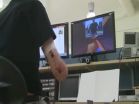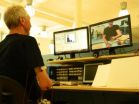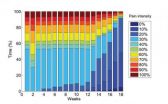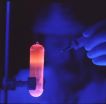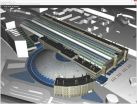(Press-News.org) VIDEO:
The film shows: 1. The patient in the augmented reality environment, 2. when he is practising specific arm movements with a racing game, 3. when he is executing random motions...
Click here for more information.
Max Ortiz Catalan, researcher at Chalmers University of Technology, has developed a new method for the treatment of phantom limb pain (PLP) after an amputation. The method is based on a unique combination of several technologies, and has been initially tested on a patient who has suffered from severe phantom limb pain for 48 years. A case study shows a drastic reduction of pain.
People who lose an arm or a leg often experience phantom sensations, as if the missing limb were still there. Seventy per cent of amputees experience pain in the amputated limb despite that it no longer exists. Phantom limb pain can be a serious chronic and deteriorating condition that reduces the quality of the person´s life considerably. The exact cause of phantom limb pain and other phantom sensations is yet unknown.
Phantom limb pain is currently treated with several different methods. Examples include mirror therapy (see fact box), different types of medication, acupuncture and hypnosis. In many cases, however, nothing helps. This was the case for the patient that Chalmers researcher Max Ortiz Catalan selected for a case study of the new treatment method he has envisaged as a potential solution.
The patient lost his arm 48 years ago, and had since that time suffered from phantom pain varying from moderate to unbearable. He was never entirely free of pain.
The patient´s pain was drastically reduced after a period of treatment with the new method (see image). He now has periods where he is entirely free of pain, and he is no longer awakened by intense periods of pain at night like he was previously.
The new method uses muscle signals from the patient´s arm stump to drive a system known as augmented reality. The electrical signals in the muscles are sensed by electrodes on the skin. The signals are then translated into arm movements by complex algorithms. The patient can see himself on a screen with a superimposed virtual arm, which is controlled using his own neural command in real time.
"There are several features of this system which combined might be the cause of pain relief" says Max Ortiz Catalan. "The motor areas in the brain needed for movement of the amputated arm are reactivated, and the patient obtains visual feedback that tricks the brain into believing there is an arm executing such motor commands. He experiences himself as a whole, with the amputated arm back in place."
Modern therapies that use conventional mirrors or virtual reality are based on visual feedback via the opposite arm or leg (see fact box). For this reason, people who have lost both arms or both legs cannot be helped using these methods.
"Our method differs from previous treatment because the control signals are retrieved from the arm stump, and thus the affected arm is in charge" says Max Ortiz Catalan. "The promotion of motor execution and the vivid sensation of completion provided by augmented reality may be the reason for the patient improvement, while mirror therapy and medicaments did not help previously."
A clinical study will now be conducted of the new treatment, which has been developed in a collaboration between Chalmers University of Technology, Sahlgrenska University Hospital, the University of Gothenburg and Integrum. Three Swedish hospitals and other European clinics will cooperate during the study which will target patients with conditions resembling the one in the case study – that is, people who suffer from phantom pain and who have not responded to other currently available treatments.
The research group has also developed a system that can be used at home. Patients will be able to apply this therapy on their own, once it has been approved. An extension of the treatment is that it can be used by other patient groups that need to rehabilitate their mobility, such as stroke victims or some patients with spinal cord injuries.
INFORMATION: END
Phantom limb pain relieved when amputated arm is put back to work
2014-02-25
ELSE PRESS RELEASES FROM THIS DATE:
Obesity prevalence remains high in US; no significant change in recent years
2014-02-25
The prevalence of obesity remains high in the U.S., with about one-third of adults and 17 percent of children and teens obese in 2011-2012, according to a national survey study in the February 26 issue of JAMA.
Obesity and childhood obesity, in particular, are the focus of many preventive health efforts in the United States, including new regulations implemented by the U.S. Department of Agriculture for food packages; funding by the Centers for Disease Control and Prevention of state- and community-level interventions; and numerous reports and recommendations issued ...
MMR vaccine linked to lower rate of infection-related hospital admissions
2014-02-25
In a nationwide group of Danish children, receipt of the live measles, mumps, and rubella (MMR) vaccine on schedule after vaccination for other common infections was associated with a lower rate of hospital admissions for any infections, but particularly for lower respiratory tract infections, according to a study in the February 26 issue of JAMA.
Childhood vaccines are recommended worldwide, based on their protective effect against the targeted diseases. However, studies from low-income countries show that vaccines may have nonspecific effects that reduce illness and ...
Patient-centered medical home program results in little improvement in quality
2014-02-25
One of the first, largest, and longest-running multipayer trials of patient-centered medical home medical practices in the United States was associated with limited improvements in quality and was not associated with reductions in use of hospital, emergency department, or ambulatory care services or total costs of care over 3 years, according to a study in the February 26 issue of JAMA.
The patient-centered medical home is a team-based model of primary care practice intended to improve the quality, efficiency, and patient experience of care. Professional associations, ...
Blood transfusion for PCI associated with increased risk of cardiac event
2014-02-25
In an analysis that included more than two million patients who underwent a percutaneous coronary intervention (PCI; procedures such as balloon angioplasty or stent placement used to open narrowed coronary arteries), there was considerable variation in red blood cell transfusion practices among hospitals across the U.S., and receiving a transfusion was associated with an increased risk of in-hospital heart attack, stroke or death, according to a study in the February 26 issue of JAMA.
Red blood cell transfusion among patients with coronary artery disease is controversial. ...
Continuous handling of receipts linked to higher urine BPA levels
2014-02-25
Study participants who handled receipts printed on thermal paper continuously for 2 hours without gloves had an increase in urine bisphenol A (BPA) concentrations compared to when they wore gloves, according to a study in the February 26 issue of JAMA.
Human exposure to bisphenol A (BPA) has been associated with adverse health outcomes, including reproductive function in adults and neurodevelopment in children exposed shortly before or after birth. "Exposure to BPA is primarily through dietary ingestion, including consumption of canned foods. A less-studied source of ...
Medical homes make small improvement in quality, do not cut costs, study finds
2014-02-25
A three-year pilot of a "medical home" model of primary care yielded few improvements in the quality of care and no reductions in hospitalizations, emergency department visits or total costs of care, according to a new RAND Corporation study.
Evaluating one of the nation's earliest and largest multipayer medical home pilots, researchers found that most participating primary care practices achieved recognition as medical homes, but the quality of care improved significantly for only one of 11 widely-used quality measures.
The findings are published in the Feb. 26 edition ...
Brain cell activity regulates Alzheimer’s protein
2014-02-25
Increased brain cell activity boosts brain fluid levels of a protein linked to Alzheimer's disease, according to new research from scientists at Washington University School of Medicine in St. Louis.
Tau protein is the main component of neurofibrillary tangles, one of the hallmarks of Alzheimer's disease. It has been linked to other neurodegenerative disorders, including frontotemporal dementia, supranuclear palsy and corticobasal degeneration.
"Healthy brain cells normally release tau into the cerebrospinal fluid and the interstitial fluid that surrounds them, but ...
'How well did you sequence that genome?' NIST, consortium partners have answer
2014-02-25
In December 2013, the U.S. Food and Drug Administration approved the first high-throughput DNA sequencer (also known commonly as a "gene sequencer"), an instrument that allows laboratories to quickly and efficiently sequence a person's DNA for genetic testing, medical diagnoses and perhaps one day, customized drug therapies. Helping get the new device approved was another first: the initial use of a reference set of standard genotypes, or "coded blueprints" of a person's genetic traits. The standard genotypes were created by the National Institute of Standards and Technology ...
Talking in 3-D: Discussing and administrating complex construction models via a web browser
2014-02-25
Redevelopment of the London King's Cross station and the nearby neighborhood was announced in 2005 and completed with a grand opening in 2012. The internationally well-recognized engineering services firm Arup, famous among other things for their work on the Opera House in Sydney, Australia, and the Allianz Arena in Munich, worked on this 400 million pound construction project. In the process, the area to the north of the station including 50 new buildings, 2,000 new apartments, 20 new streets and ten new public squares was being renewed. Thus, a great challenge was to ...
Air Force aircraft returned from Vietnam is postwar source of Agent Orange contamination
2014-02-25
February 25, 2014 -- From 1971-1982, Air Force reservists, who flew in 34 dioxin-contaminated aircraft used to spray Agent Orange and returned to the U.S. following discontinuation of the herbicide spraying operations in the Vietnam War, were exposed to greater levels of dioxin than previously acknowledged, according to a study published today in Environmental Research by senior author Jeanne Mager Stellman, PhD, professor emerita at the Mailman School of Public Health's Department of Health Policy and Management.
"These findings are important because they describe ...
